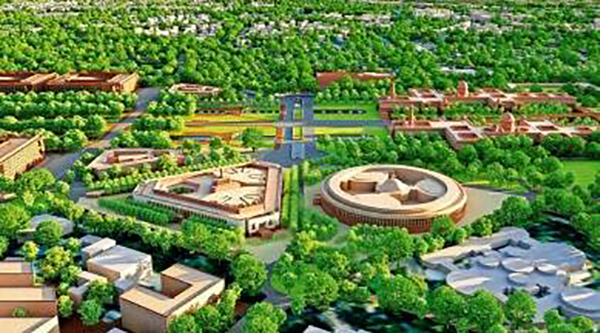 On May 28, Prime Minister Narendra Modi is set to officially inaugurate the newly constructed Parliament building in the Central Vista of Delhi, India.
On May 28, Prime Minister Narendra Modi is set to officially inaugurate the newly constructed Parliament building in the Central Vista of Delhi, India.
The newly constructed four-storey building, covering a vast area of 64,500 square meters, has been built at an estimated cost of Rs 970 crore. It will feature an impressive collection of nearly 5,000 art pieces.
The new Parliament is situated on a triangular plot next to the current Parliament House. The foundation stone for this significant structure was laid by the Prime Minister in December 2020, and Tata Projects Limited has carried out its construction.
The new Parliament building, designed by HCP designs and conceptualized by Chief Architect Bimal Patel, incorporates elements that represent India as a rising power. The architects intentionally designed the building in the shape of a triangle to optimize space utilization and embrace the profound “geometric significance” associated with this shape.
Bimal Patel explained that triangles hold sacred importance in various contexts, such as the Sri Yantra and the concept of Trinities. The Lok Sabha will occupy the north-west corner, the Rajya Sabha will be situated in the south-west corner, and the lounge area will be located in the eastern corner within the triangular structure.
The new Lok Sabha and Rajya Sabha houses
It features notable changes and design elements. In the new Parliament, the Lok Sabha Hall will accommodate 888 seats, a significant increase from the 543 seats in the old Parliament House.
Similarly, the Rajya Sabha hall will have a seating capacity of 300, compared to 250 in its previous counterpart. The new Lok Sabha chamber is triple the size of the one in the current building. It will also have an additional capacity of up to 1,140 seats to facilitate joint sessions of both houses since there is no Central Hall in the new Parliament. In the old Parliament, joint sessions were held in the Central Hall, which could accommodate 436 individuals, with additional seating arrangements made for such occasions.
The new design follows a traditional color scheme, with green representing the Lok Sabha and red symbolizing the Rajya Sabha. However, the architects have incorporated various elements inspired by India’s cultural heritage into the design of both Houses. The Lok Sabha embraces the Peacock motif in its carpets and ceiling design, while the Rajya Sabha’s ceiling design draws inspiration from the Lotus motif, as stated by Bimal Patel.
Furthermore, in contrast to the previous Parliament building, the new Parliament ensures abundant natural light for both the Lok Sabha and Rajya Sabha. This has been achieved













